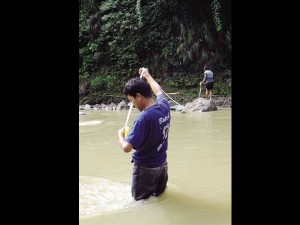P11.2-B dam puts Ilonggos on edge

ARTIST’S DRAWING of the P11.2-billion dam project in Iloilo, which, when completed, will be the biggest dam outside Luzon CONTRIBUTED PHOTO
ILOILO CITY—President Benigno Aquino might not be aware of it, but the P11.2-billion dam in Iloilo he cited in his State of the Nation Address on Monday as one of his administration’s centerpiece projects has drawn warnings over its safety and environmental impact.
The Iloilo-based People’s Movement for Jalaur River (PMJR) accused the government of “cramming” the Jalaur River Multipurpose Project 2 (JRMP II) despite the opposition of affected residents and environmental risks. It “has failed to address these concerns and has even belittled or ignored warnings,” the group’s spokesperson, Grace Lobaton, said.
The PMJR is an alliance of people’s organizations, church groups, indigenous communities, environmental advocates and scientists.
During his speech before lawmakers, the President said the proposed JRMP II, the biggest dam out of Luzon, would prevent widespread flooding in Iloilo and generate an additional 6.6 megawatts to power consumers.
It would benefit 24,000 farmers from year-round irrigation, create 17,000 jobs during construction, and provide livelihood to 32,000 workers upon completion, he said.
Project funding will come from a $203-million official development assistance by South Korea through its Export-Import Bank’s Economic Cooperation Fund. The Philippines will provide a counterpart fund of P2.2 billion.
Flooding threat
Rather than prevent flooding, the PMJR cited “a very great danger that downstream communities will experience flooding once the dam is constructed.”
“[Dam] operators are inclined to keep higher levels of water as the turbines of the hydroelectric facilities operate better with higher volume of water … but [they] open the floodgates when water volume threatens to break the dam,” the group said in a briefing paper.
“When the floodgates are opened, it causes flooding in the downstream communities,” it said.
The group said the project would also dislocate thousands of Tumandok people, the largest indigenous group on Panay Island, in 13 villages, including Agcalaga, Masaroy, and Garangan in Calinog town and Tampucao in Lambunao town.
The JRMP II involves the construction of a 102-meter dam and a 6.6-MW hydroelectric plant. It is set to be completed in June 2016. It is designed to boost the production of 22,230 hectares of irrigated farmlands and 9,500 ha of rain-fed areas.
The first phase, JRMP I, was implemented from 1977 to 1983. It involved the rehabilitation of four irrigation systems, covering 22,000 ha of rice fields.
Close to fault line

MEMBERS of an environmental investigation mission conduct tests and take measurements on the project site in September 2012. PHOTO FROM AGHAM
Called for a thorough review of the project, the PMJR said the proposed mega-dam in Barangay Agcalaga was close to the active West Panay fault line, where an earthquake caused massive destruction on Panay Island in 1948.
Agcalaga and its neighboring villages are highly susceptible to landslides, Lobaton said, citing a Rapid Geohazard Assessment report of the Mines and Geosciences Bureau, an attached agency of the Department of Environment and Natural Resources.
A three-member team of Samahan ng Nagtataguyod ng Agham at Teknolohiya Para sa Sambayanan, which assessed the project site in September last year, noted geologic “joints” or fractures and movements in rock formations in the area, which, it said, could indicate weaknesses in the proposed dam’s foundation.
“Further studies are necessary to determine the feasibility of the area and the design of the dam,” geologist Adrian Raymond Fernandez said in an interview.
Phivolcs assurance
However, the Philippine Institute of Volcanology and Seismology (Phivolcs) has assured the safety of the site. It is not prone to the hazards of ground rapture in case of a movement along the Western Panay fault, the government agency’s director, Renato Solidum Jr., said.
But Solidum recommended the creation of a buffer zone measuring 5 meters on both sides of the fault line as a safety measure.
The main dam and reservoir will rise 11 kilometers from the fault line, while one of its components, Ulian High Dam, is
5 km away.
Mayor Alex Centena of Calinog town, the main project site, said the dam would significantly help his constituents by providing jobs and stimulating economic growth. The fourth-class municipality (annual income: P25 million to P34 million) is 53 km north of Iloilo City and has a population of 68,000.
Drilon defense
Senate President Franklin Drilon, an Ilonggo and main project proponent, has also defended the JRMP II. He said it would “improve agricultural productivity which will be Iloilo’s contribution to the rice self-sufficiency target of the government.”
“This project will increase the irrigated lands in the region by around 10 percent and the annual regional rice production by around 5 percent. It will likewise expand the production areas of sugarcane and other crops,” he said in a statement.
The PMJR is pushing for a congressional inquiry to determine the feasibility and environmental and social impact of the project. It has also launched protest actions, with the support of Tumandok communities.














